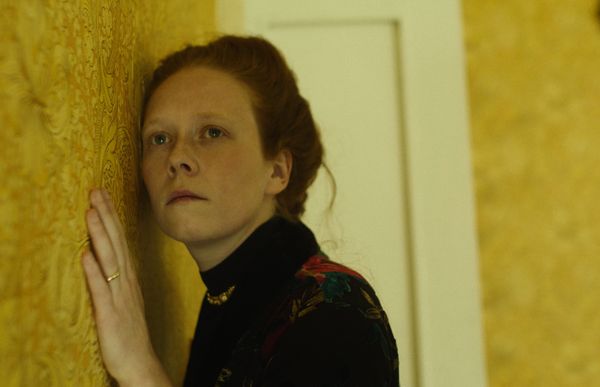Eye For Film >> Movies >> The Yellow Wallpaper (2021) Film Review
The Yellow Wallpaper
Reviewed by: Jennie Kermode

Designing wallpaper is trickier than it looks. A good pattern has to be simple enough to be easily aligned when the paper is pasted on a wall yet complex enough to avoid causing irritation with its repetition. It has to be engaging enough to make a sale yet forgettable enough to avoid becoming a distraction. In the Victorian era, patterns featuring flowers and twisting vines predominated in the West, intended to invoke the natural world. The architect AWN Pugin condemned this approach, arguing that their 3D effect, when presented on a flat wall, created a disorientating effect, misleading the viewer into thinking that there was something beyond or inside them.
Charlotte Perkins Gilman's 1892 short story hinges on this effect. Though it has been adapted several times for stage and screen, it is very difficult to capture well, as much of it takes place within its heroine's mind or within her relationship with the wallpaper in the room where she is kept. In this instance she - Jane - is played by Alexandra Loreth, who wrote this adaptation, which perhaps gives it something of an edge. Director Kevin Pontuti and cinematographer Sonja Tsypin also contribute a great deal, however, using every trick in the book to bring the wallpaper to life yet never consigning it firmly to the realm of the psychotic or the supernatural. A particular highlight which also aligns closely with the text of the story is a scene in which Jane presses herself against the wall and inches along it, illuminated by moonlight shining through a barred window which has water running down the glass. This causes the pattern to shift and mutate unpredictably, an effect which becomes more disturbing the more closely one observes it.
Jane has no choice but to observe the wallpaper for lengthy periods of time. The film opens with a shocking incident which may or may not be real. It almost doesn't matter. Jane is instinctively rejecting everything that the society of the time tells her she should be. She's at odds with the patterns of it: not maternal, not domestic, but desirous of an intellectual existence, of the opportunity to write. Like Gilman herself, she is consequently considered to be suffering from a nervous disorder and is prescribed a lengthy rest cure by her doctor husband John (Joe Mullins). From the outset, she feels that something about the room with the yellow wallpaper is amiss, but she does not have jurisdiction over her affairs, and there is always the threat of institutionalisation. Forbidden from reading, she has nothing to exercise her mind except that pattern. Even outside, nature seems to mimic it. The low hedges that frame her existence. The curling pattern of vines built into the end of a bench. This is a low budget film but the production design is full of little touches that carry us back to the same nightmarish place.
By its nature, this story unfolds slowly and requires some patience from the viewer. Pontuti presents the early stages as a mystery, allowing us to wonder what is unfolding between the couple and why they have come to this place, then draws us in with clever imagery to buy time for Loreth to hook us with her performance. This must needs be restrained to begin with as Jane tries to perform sanity for those around her, but of course the question is whether she would be mad at all if not obliged to live in this way. There is little evidence of love in her marriage, at least on her part. The film's only sex scene focuses on her head, tilted back, face vacant, her eyes on the wallpaper.
Built layer upon layer with patient deliberation, this is a film that tightens its grip like a yellow boa constrictor, eyes fully focused, hypnotising and suffocating. The sense of a creeping presence described in the text is let slip here only in brief asides before Jane herself begins to take on the character of the figure she imagines she sees in that shifting yellow paper. The physical change is initially subtle, framed by careful choices of shot: Jane leaning to look out of a window, stooping to examine a flower. It gradually becomes suggestive of physical pressure bearing down on her, trying to crush her even as she strives to move forwards. One thinks of Ted Hughes' Jaguar - which came later, of course, when the boa constrictor was naught but a fossil - and his discovery of freedom through the simple means of letting go of reality.
Some people, of course, will complain that this is a film in which nothing happens, their own faces pressed up so close to the wallpaper that they fail to recognise the pattern, fail to realise that that's exactly where the real horror lies.
Reviewed on: 22 Mar 2021














